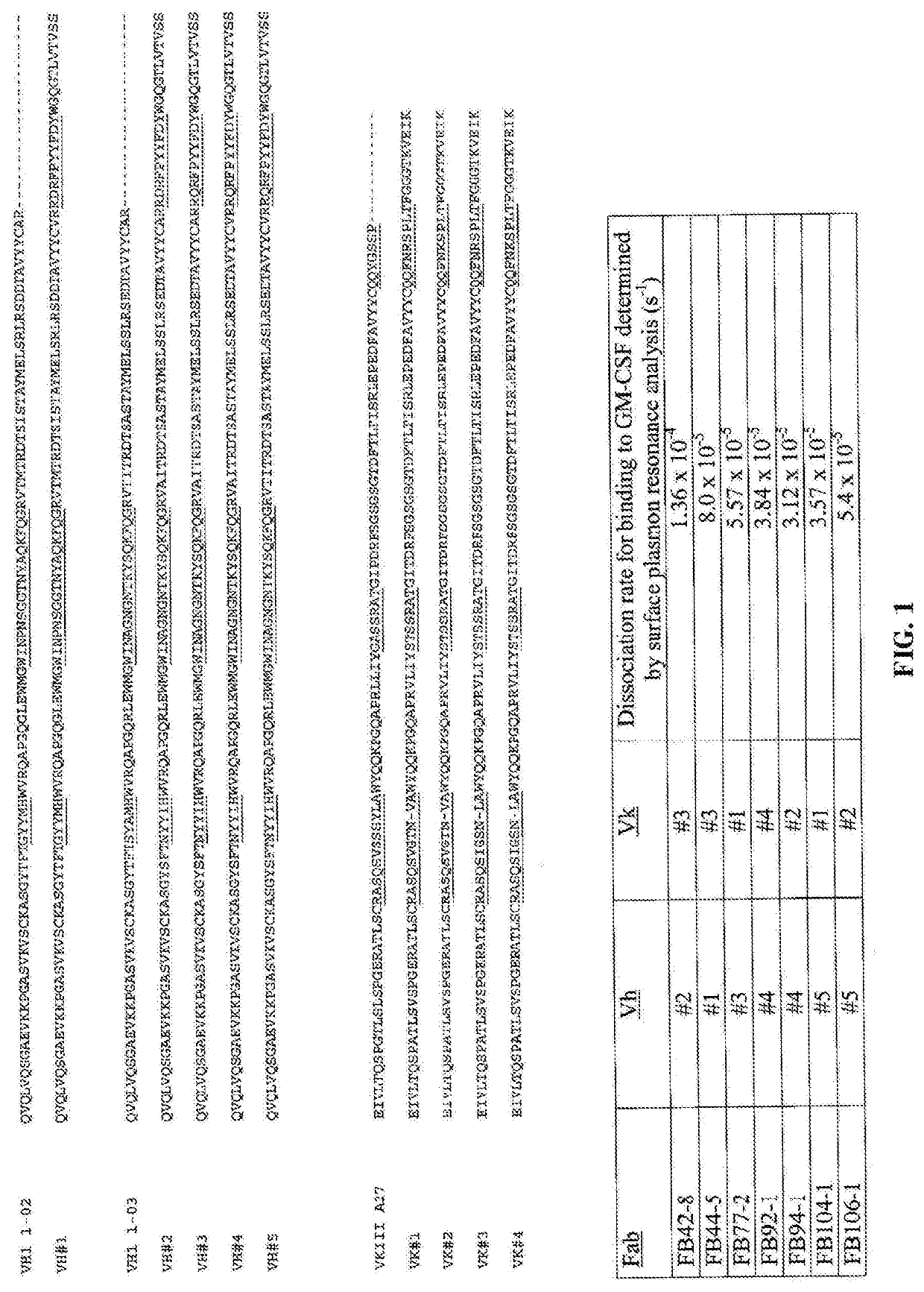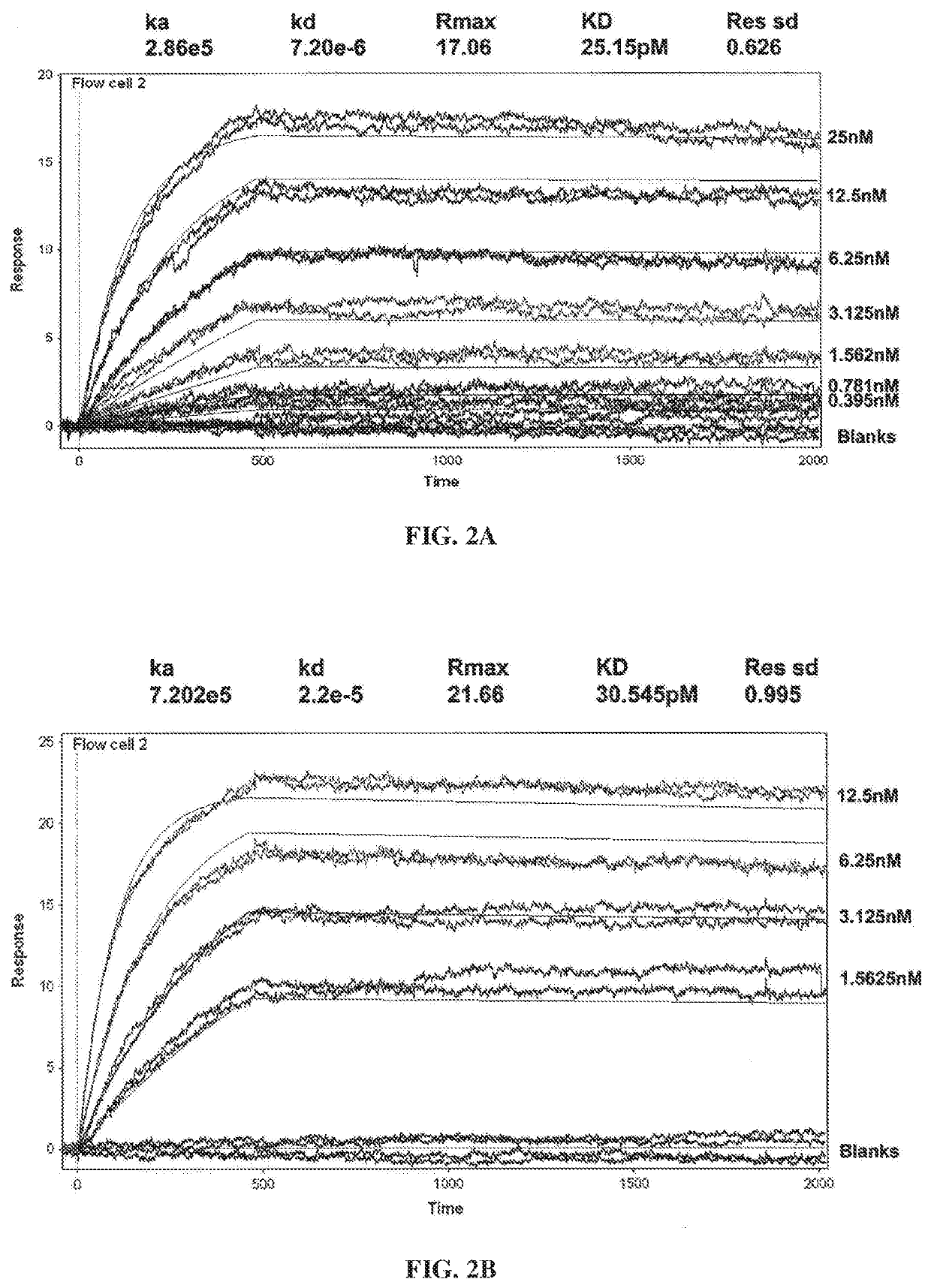Methods of treating immunotherapy-related toxicity using a gm-csf antagonist
- Summary
- Abstract
- Description
- Claims
- Application Information
AI Technical Summary
Benefits of technology
Problems solved by technology
Method used
Image
Examples
example 1
Humaneered Antibodies to GM-CSF
[0336]A panel of engineered Fab′ molecules with the specificity of c19 / 2 were generated from epitope-focused human V-segment libraries as described in US patent application publication nos. 20060134098 and 20050255552. Epitope-focused libraries were constructed from human V-segment library sequences linked to a CDR3-FR4 region containing BSD sequences in CDRH3 and CDRL3 together with human germ-line J-segment sequences. For the heavy chain, human germ-line JH4 sequence was used and for the light chain, human germ-line JK4 sequence was used.
[0337]Full-length Humaneered V-regions from a Vh1-restricted library were selected that supported binding to recombinant human GM-CSF. The “full-length” V-kappa library was used as a base for construction of “cassette” libraries as described in US patent application publication no. 20060134098, in which only part of the murine c19 / 2 antibody V-segment was initially replaced by a library of human sequences. Two types ...
example 2
n of a Humaneered GM-CSF Antibody
[0342]This example evaluates the binding activity and biological potency of a humaneered anti-GM-CSF antibody in a cell-based assay in comparison to a chimeric IgG1k antibody (Ab2) having variable regions from the mouse antibody LMM102 (Nice et al., Growth Factors 3:159, 1990). Ab1 is a humaneered IgG1k antibody against GM-CSF having identical constant regions to Ab2.
Surface Plasmon Resonance Analysis of Binding of Human GM-CSF to Ab1 and Ab2
[0343]Surface Plasmon resonance analysis was used to compare binding kinetics and monovalent affinities for the interaction of Ab1 and Ab2 with glycosylated human GM-CSF using a Biacore 3000 instrument. Ab1 or Ab2 was captured onto the Biacore chip surface using polyclonal anti-human F(ab′)2. Glycosylated recombinant human GM-CSF expressed from human 293 cells was used as the analyte. Kinetic constants were determined in 2 independent experiments (see FIGS. 2A-2B and Table 3). The results show that GM-CSF bound t...
example 3
ation of a Neutralizing Anti-GM-CSF Antibody in a Mouse Model of Immunotherapy-Related Toxicity
[0350]A mouse model of immunotherapy-related toxicity can be used to show the efficacy of an anti-GM-CSF antibody for preventing and treating immunotherapy-related toxicity. In one model of immunotherapy-related toxicity, mice are injected with CAR T-cells in doses provoking toxicity. For example, van der Stegen et al. (J. Immunol 191:4589-4598 (2013)), incorporated herein by reference, describe a CRS model induced by the i.p. injection of a single dose of 30×106 cells termed Tr T cells. T4′ T cells are engineered T cells expressing the chimeric Ag receptor (CAR) T1E28z. T cells engineered to express T1E28z are activated by cells expressing ErbB1- and ErbB4-based dimers and ErbB2 / 3 heterodimer.
[0351]To evaluate the efficacy of anti-GM-CSF antibodies for preventing and treating CRS, mice will be divided in groups (n=10), each group receiving either: a) a single i.p. saline injection; b) an ...
PUM
| Property | Measurement | Unit |
|---|---|---|
| Molar density | aaaaa | aaaaa |
| Molar density | aaaaa | aaaaa |
| Molar density | aaaaa | aaaaa |
Abstract
Description
Claims
Application Information
 Login to View More
Login to View More - R&D
- Intellectual Property
- Life Sciences
- Materials
- Tech Scout
- Unparalleled Data Quality
- Higher Quality Content
- 60% Fewer Hallucinations
Browse by: Latest US Patents, China's latest patents, Technical Efficacy Thesaurus, Application Domain, Technology Topic, Popular Technical Reports.
© 2025 PatSnap. All rights reserved.Legal|Privacy policy|Modern Slavery Act Transparency Statement|Sitemap|About US| Contact US: help@patsnap.com



